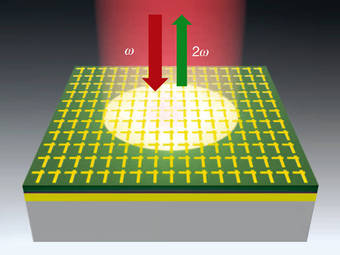Hocheffiziente nichtlineare Metamaterialien für die Laser-Technik
2014-07-03 – Nachrichten aus dem Physik-Department

Laser haben sich für viele Anwendungen fest etabliert. Doch noch immer gibt es Wellenlängen, für die es keine oder nur sehr große und teure Systeme gibt. Andererseits werden für die Sensorik und für medizinische Anwendungen kompakte Lasersysteme gesucht, beispielsweise für Wellenlängen vom nahen Infrarot bis in die Terahertz-Region.
Forscher der Technischen Universität München und der University of Texas in Austin (USA) haben nun einen nur 400 Nanometer dicken nichtlinearen Spiegel entwickelt, der die Frequenz des eingestrahlten Lichts verdoppelt. Dafür reicht eine Eingangslichtintensität wie die eines Laserpointers. Gemessen an der Eingangsintensität und der Strukturdicke sind die neuen optischen Bausteine etwa eine Million mal effizienter als die besten herkömmlichen nichtlinearen Materialien.
Während beim Einsatz konventioneller Materialien mit nichtlinearen optischen Eigenschaften die Phasengeschwindigkeiten der Eingangs- und Ausgangswellen genau abgestimmt werden müssen, entfällt diese Einschränkung bei dem neuen Material. Seine Gesamtdicke ist deutlich kürzer ist als die Wellenlänge.
Das Supersandwich
Das Wundermaterial der Physiker besteht aus einer Abfolge dünner Schichten aus Indium, Gallium und Arsen einerseits und Aluminium, Indium und Arsen andererseits. Knapp 100 dieser Schichten, jede zwischen einem und zwölf Nanometer dick, stapeln sie übereinander.
Auf der Oberfläche befindet sich ein Muster aus asymmetrischen, kreuzartigen Strukturen aus Gold, auf der Unterseite eine durchgängige Goldschicht. Mit der Schichtdicke und der Oberflächenstruktur besitzen die Forscher zwei Stellschrauben, mit denen sie die Struktur auf die jeweilige Wellenlänge präzise maßschneidern können.
Licht mit 8000 Nanometern Wellenlänge verwandelt das Material in Licht mit 4000 Nanometern Wellenlänge. „Mit Laserlicht in diesem Frequenzbereich lassen sich beispielsweise Gassensoren für die Umwelttechnik bauen“, sagt Frederic Demmerle, Mitarbeiter des Projekts am Walter Schotty Institut der TU München.

Kleiner als die Wellenlänge
Die Fähigkeit, die Frequenz eines Lichtstrahls zu verdoppeln, beruht auf den speziellen elektronischen Eigenschaften des Materials. Weil die Halbleiterschichten nur wenige Nanometer dick sind, können die von den elektromagnetischen Schwingungen des Lichts angeregten Elektronen nur noch ganz bestimmte Zustände einnehmen.
„Eine solche Struktur nennen wir gekoppelte Quantentöpfe“, sagt Frederic Demmerle. „Indem wir nun in einem exakt definierten Abstand eine weitere dünne Schicht folgen lassen, können wir diese Zustände zusammenschieben oder auseinander ziehen und damit genau auf die gewünschte Wellenlänge einstellen.“
Einen wichtigen Anteil an der hohen Effizienz des Bausteins hat das von den Forschern an der University of Texas unter der Leitung der Professoren Michail Belkin und Andrea Alu entwickelte Muster aus asymmetrischen, kreuzförmigen Goldstrukturen. Das Design dieser Strukturen können die Forscher optimal auf maximale Resonanz mit den Ein- und Ausgangsfrequenzen abstimmen.
Die Muster sind zwar wesentlich kleiner als die Wellenlänge des Lichtes, doch die regelmäßige metallische Struktur sorgt dafür, dass das Licht in das Material einkoppelt. Ihre besondere Form führt dazu, dass es an bestimmten Stellen starke Feldüberhöhungen gibt, die die Einkopplung noch verstärken. „Es ist diese spezifische Kombination von Halbleitermaterial und Gold-Nanostrukturen, die die extrem große nichtlineare Reaktion produziert“ sagt Frederic Demmerle.
Terahertz-Strahlung
In Zukunft wollen die Physiker nach diesem Muster weitere Materialien für andere nicht-lineare Effekte entwickeln. „Denkbar ist neben der Frequenzverdopplung auch die Frequenzhalbierung sowie die Erzeugung von Summen- oder Differenzfrequenzen“, sagt Jongwon Lee, Forscher an der University of Texas und Erstautor der Publikation. „Mit solchen Bausteinen ließe sich dann beispielsweise Terahertz-Strahlung erzeugen und detektieren. Auf diese Strahlung setzt die Medizin, weil sie biologisches Gewebe nicht schädigt.“
„Indem sie außergewöhnliche elektromagnetische Wechselwirkungen und die Quantenphysik von Metamaterialien miteinander verknüpft, eröffnet diese Arbeit ein völlig neues Forschungsfeld im Bereich der nichtlinearen Optik“, sagt Professorin Andrea Alu.
„Weil sie nicht mehr dem Zwang zur Anpassung der Phasengeschwindigkeit unterliegen, eröffnen die in dieser Arbeit entwickelten ultradünnen nichtlinearen optischen Elementen neue Wege zu effizienten Bausteinen für die Frequenzkonversion“, sagt Professor Mikhail Belkin.
Die Arbeit der Forschungsgruppe der University of Texas wurde gefördert von der National Science Foundation der USA, der US Air Force (Office of Scientific Research), des US Office of Naval Research. Die Arbeiten im Walter Schottky Institut wurden von der Deutschen Forschungsgemeinschaft im Rahmen der Exzellenzinitiative (Cluster of Excellence Nanosystems Initiative Munich, NIM) gefördert.
- Redaktion
- Dr. Andreas Battenberg
Veröffentlichung
Kontakt
- Prof. Dr. Markus C. Amann
- HalbleitertechnologieTechnische Universität MünchenAm Coulombwall 485748 GarchingTel.: +49 89 289-11580E-Mail: markus-christian.amann@tum.de